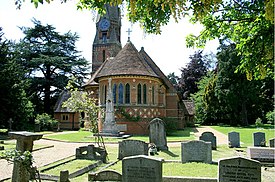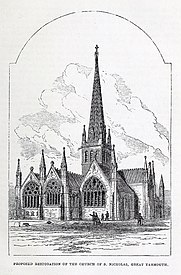John Pollard Seddon
John Pollard Seddon FRIBA (19 September 1827 – 1 February 1906)[1] was a British architect, working largely on churches.
His father was a cabinetmaker, and his brother, Thomas Seddon (1821–1856), was a landscape painter. Born in London,[2] he was educated at Bedford School.[3] He was later a pupil of Thomas Leverton Donaldson, though Donaldson was a classical architect and Seddon preferred the Gothic Revivalism of John Ruskin.[4]
Between 1852 and 1863, Seddon formed a partnership with John Prichard. Many of their major commissions were church restoration works, most famously for Llandaff Cathedral. In 1871 he submitted a design in a competition for Holloway Sanatorium.
C. F. A. Voysey was articled as a pupil of Seddon in 1873.[4] From 1884 to 1904 he was in partnership with John Coates Carter.
In 1904 he was Diocesan Architect for London and designed a gigantic Imperial Monumental Halls, with a tall tower, to be added to Westminster Abbey; it was intended to restore the dominance of the abbey over the surrounding crowd of towers and monuments. However, the cost of construction was prohibitive and it remained unbuilt.[5]
His works include the University College of Wales building in Aberystwyth; St Peter's Church, Ayot St Peter, Hertfordshire; St Nicholas Church, Great Yarmouth;[6] St Catherine's Church, Hoarwithy, Herefordshire; and, with Prichard, the Church of St John, Llandenny;[7] the 1858–9 rebuild of St Mary's Church, Aberavon, and limited extensions to Dingestow Court, Monmouthshire, including the stables.[8] He was also a prolific designer of furniture, metalwork, stained glass, tiles and ceramics.
-
Church at Ayot St Peter
References[edit]
- ^ 'Obituary', The Builder, 10 February 1906, p. 150.
- ^ Press, Oxford University; Bury, Stephen (21 June 2012). Benezit Dictionary of British Graphic Artists and Illustrators. OUP USA. ISBN 978-0-19-992305-2.
- ^ "Who's Who".
- ^ a b Durant, Stuart. "Voysey and his first mentor, John Pollard Seddon". Victorian Web. Retrieved 10 March 2013.
- ^ Wainwright, Oliver (24 October 2011). "Top 10 unbuilt towers: Imperial Monumental Halls, by J P Seddon & E B Lamb". Building Design. Retrieved 16 October 2014.
- ^ Seddon, J.P. (1864). "S. Nicholas' Church, Great Yarmouth, Norfolk". The Ecclesiologist. 25: 28–34.
- ^ The Buildings of Wales: Gwent/Monmouthshire, page 272
- ^ The Buildings of Wales: Gwent/Monmouthshire, page 212



